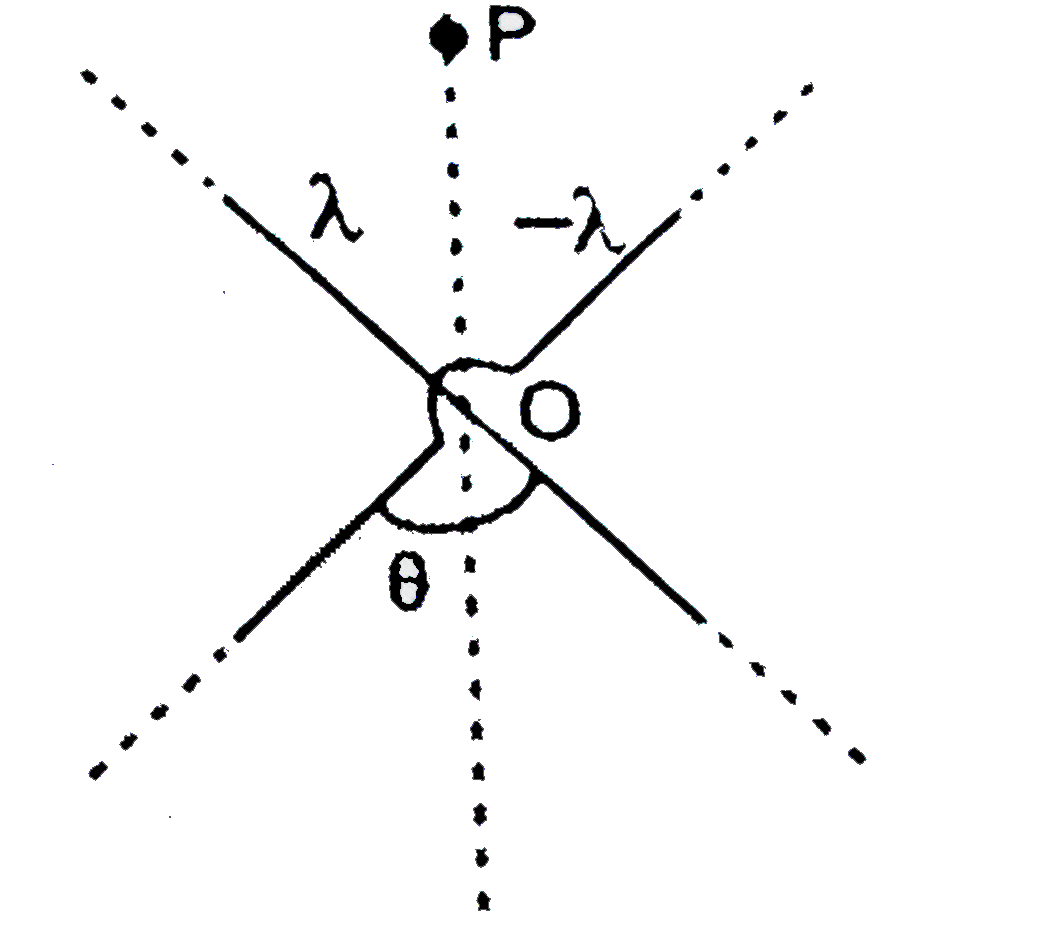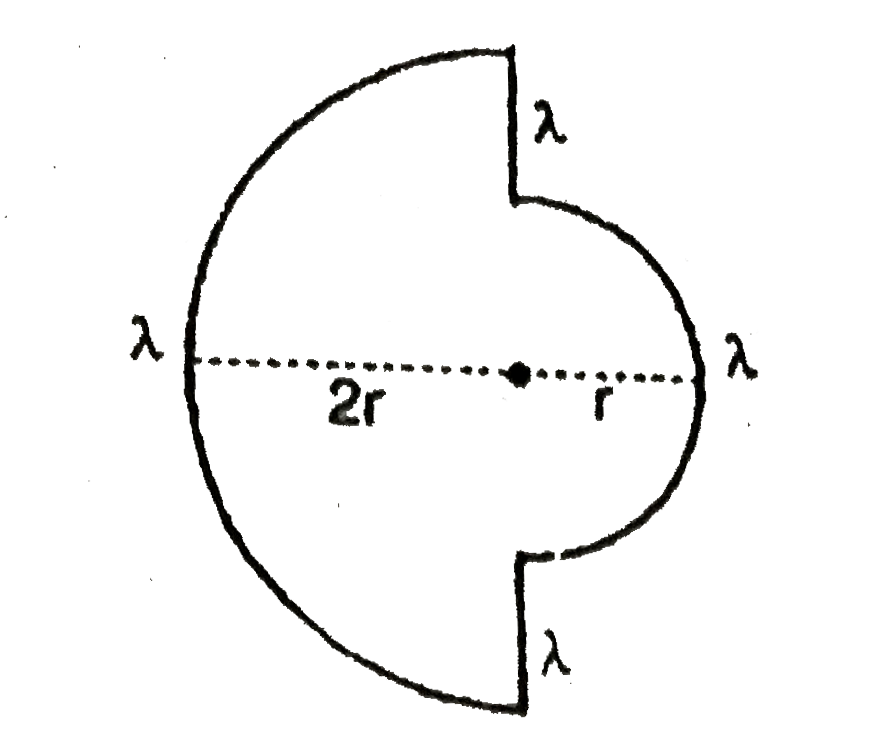A long charged cylinder of linear charge density λ is surrounded by a hollow co-axial conducting cylinder. What is the electric field in the space between the two cylinders ?
To find the electric field in the space between a long charged cylinder of linear charge density λ and a surrounding hollow coaxial conducting cylinder, we can use Gauss's law. Here’s a step-by-step solution:
Step 1: Understand the Configuration
We have a long charged cylinder with a linear charge density λ and a coaxial conducting cylinder surrounding it. The inner cylinder has a radius RA and the outer conducting cylinder has a radius RB.
Step 2: Choose a Gaussian Surface
To apply Gauss's law, we need to select a cylindrical Gaussian surface that lies between the two cylinders. Let the radius of this Gaussian surface be R such that RA<R<RB.
Step 3: Apply Gauss's Law
Gauss's law states that the electric flux ΦE through a closed surface is equal to the charge enclosed Qenc divided by the permittivity of free space ϵ0:
ΦE=Qencϵ0
Step 4: Calculate the Electric Flux
The electric flux through the curved surface of the cylindrical Gaussian surface is given by:
ΦE=E⋅A
where A is the curved surface area of the cylinder, which is 2πRL (where L is the length of the cylinder).
Thus, we have:
ΦE=E⋅(2πRL)
Step 5: Determine the Charge Enclosed
The charge enclosed by the Gaussian surface is simply the charge on the inner cylinder. The charge Qenc is given by:
Qenc=λL
Step 6: Set Up the Equation
Substituting the expressions for electric flux and charge into Gauss's law:
E⋅(2πRL)=λLϵ0
Step 7: Solve for Electric Field E
We can cancel L from both sides (assuming L≠0):
E⋅(2πR)=λϵ0
Now, solving for E:
E=λ2πϵ0R
Conclusion
The electric field in the space between the two cylinders is given by:
E=λ2πϵ0R
We have a long charged cylinder with a linear charge density λ and a coaxial conducting cylinder surrounding it. The inner cylinder has a radius RA and the outer conducting cylinder has a radius RB.
To apply Gauss's law, we need to select a cylindrical Gaussian surface that lies between the two cylinders. Let the radius of this Gaussian surface be R such that RA<R<RB.
Gauss's law states that the electric flux ΦE through a closed surface is equal to the charge enclosed Qenc divided by the permittivity of free space ϵ0:
ΦE=Qencϵ0
The electric flux through the curved surface of the cylindrical Gaussian surface is given by:
ΦE=E⋅A
where A is the curved surface area of the cylinder, which is 2πRL (where L is the length of the cylinder).
ΦE=E⋅(2πRL)
The charge enclosed by the Gaussian surface is simply the charge on the inner cylinder. The charge Qenc is given by:
Qenc=λL
Substituting the expressions for electric flux and charge into Gauss's law:
E⋅(2πRL)=λLϵ0
We can cancel L from both sides (assuming L≠0):
E⋅(2πR)=λϵ0
Now, solving for E:
E=λ2πϵ0R
The electric field in the space between the two cylinders is given by:
E=λ2πϵ0R
Topper's Solved these Questions
- ELECTROSTATIC POTENTIAL AND CAPACITANCEBOOK - NCERT ENGLISHCHAPTER - ELECTROSTATIC POTENTIAL AND CAPACITANCEEXERCISE - Exercise
37 Videos
- ELECTROMAGNETIC WAVESBOOK - NCERT ENGLISHCHAPTER - ELECTROMAGNETIC WAVESEXERCISE - Exercise
15 Videos
- MAGNETISM AND MATTERBOOK - NCERT ENGLISHCHAPTER - MAGNETISM AND MATTEREXERCISE - Exercise
25 Videos
Similar Questions
Two parallel infinite line charges +λand−λ are placed with a separation distance R in free space. The net electric field exactly mid-way between the two line charges is
View SolutionTwo parallel infinite line charges with linear charge densities +λC/m and −λ C/m are placed at a distance of 2R in free space. What is the electric field mid-way between the two line charges?
View SolutionA very long uniformly charged cylinder (radius R) has a surface charge density σ . A very long uniformaly charged line charge( linear charge density λ) is placed along the ctlinder axis. If electric field intensity vector outside the cylinder is zerom then :
View SolutionAn infinite line charge of uniform electric charge density λ lies along the axis of an electrically conducting infinite cylindrical shell of radius R. At time t=0, the space inside the cylinder is filled with a material of permittivity ε and electrical conductivity σ. The electrical conduction in the material follows Ohm's law. Which one of the following graphs best describes the subsequent variation of the magnitude of current density j(t) at any point in the material ?
View SolutionAn infinitely long wire with linear charge density +λ is bent and the two parts are inclined at angle 30∘ as shown in fig, the electric field at point P is :

View SolutionTwo infinitely long thin straight wires having uniform linear charge densities λ and 2λ are arranged parallel to each other at a distance r apart.The intensity of the electric field at a point midway between them is
View SolutionA long wire with a uniform charge density λ is bent in two configurations shown in fig. Determine the electric field intensity at point O.

View Solution(i) Two infinitely long line charges each of linear charge density λ are placed at an angle θ as shown in figure. Find out electric field intensity at a point P, which is at a distance x from point O along angle bisector of line charges.

(ii) Repeat the above question if the line charge densities are λ and −λ. as shown in figure.

View SolutionTwo semicircular rings lying in same plane, of uniform linear charge density λ have radius r and 2r. They are joined using two straight uniformly charged wires of linear charge density λ and length r as shown in figure. The magnitude of electric field at common centre of semi circular rings is -

View SolutionTwo semicircular rings lying in same plane, of uniform linear charge density λ have radius r and 2r. They are joined using two straight uniformly charged wires of linear charge density λ and length r as shown in figure. The magnitude of electric field at common centre of semi circular rings is -

View Solution
